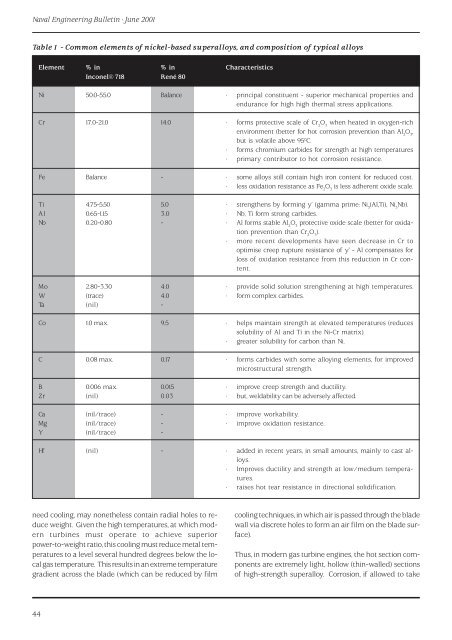Engineering - Royal Australian Navy
Engineering - Royal Australian Navy
Engineering - Royal Australian Navy
Create successful ePaper yourself
Turn your PDF publications into a flip-book with our unique Google optimized e-Paper software.
Naval <strong>Engineering</strong> Bulletin • June 2001<br />
Table 1 - Common elements of nickel-based superalloys, and composition of typical alloys<br />
Element % in % in Characteristics<br />
Inconel® 718 René 80<br />
Ni 50.0-55.0 Balance • principal constituent - superior mechanical properties and<br />
endurance for high high thermal stress applications.<br />
Cr 17.0-21.0 14.0 • forms protective scale of Cr 2<br />
O 3<br />
when heated in oxygen-rich<br />
environment (better for hot corrosion prevention than Al 2<br />
O 3<br />
,<br />
but is volatile above 95 0 C.<br />
• forms chromium carbides for strength at high temperatures<br />
• primary contributor to hot corrosion resistance.<br />
Fe Balance - • some alloys still contain high iron content for reduced cost.<br />
• less oxidation resistance as Fe 2<br />
O 3<br />
is less adherent oxide scale.<br />
Ti 4.75-5.50 5.0 • strengthens by forming y’ (gamma prime: Ni 3<br />
(Al,Ti), Ni 3<br />
Nb).<br />
Al 0.65-1.15 3.0 • Nb, Ti form strong carbides.<br />
Nb 0.20-0.80 - • Al forms stable Al 2<br />
O 3<br />
protective oxide scale (better for oxidation<br />
prevention than Cr 2<br />
O 3<br />
).<br />
• more recent developments have seen decrease in Cr to<br />
optimise creep rupture resistance of y’ - Al compensates for<br />
loss of oxidation resistance from this reduction in Cr content.<br />
Mo 2.80-3.30 4.0 • provide solid solution strengthening at high temperatures.<br />
W (trace) 4.0 • form complex carbides.<br />
Ta ( n il) -<br />
Co 1.0 max. 9.5 • helps maintain strength at elevated temperatures (reduces<br />
solubility of Al and Ti in the Ni-Cr matrix).<br />
• greater solubility for carbon than Ni.<br />
C 0.08 max. 0.17 • forms carbides with some alloying elements, for improved<br />
microstructural strength.<br />
B 0.006 max. 0.015 • improve creep strength and ductility.<br />
Zr (nil) 0.03 • but, weldability can be adversely affected.<br />
Ca (nil/trace) - • improve workability.<br />
Mg (nil/trace) - • improve oxidation resistance.<br />
Y (nil/trace) -<br />
Hf (nil) - • added in recent years, in small amounts, mainly to cast alloys.<br />
• Improves ductility and strength at low/medium temperatures.<br />
• raises hot tear resistance in directional solidification.<br />
need cooling, may nonetheless contain radial holes to reduce<br />
weight. Given the high temperatures, at which modern<br />
turbines must operate to achieve superior<br />
power-to-weight ratio, this cooling must reduce metal temperatures<br />
to a level several hundred degrees below the local<br />
gas temperature. This results in an extreme temperature<br />
gradient across the blade (which can be reduced by film<br />
cooling techniques, in which air is passed through the blade<br />
wall via discrete holes to form an air film on the blade surface).<br />
Thus, in modern gas turbine engines, the hot section components<br />
are extremely light, hollow (thin-walled) sections<br />
of high-strength superalloy. Corrosion, if allowed to take<br />
44
















